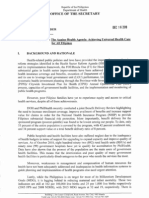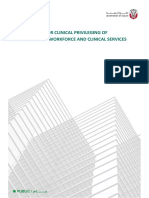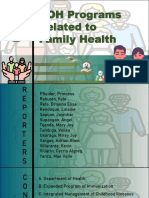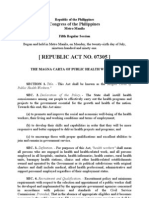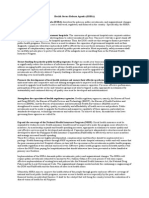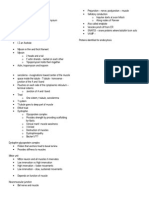Kalusugan Pangkalahatan
Kalusugan Pangkalahatan
Uploaded by
pazucenaCopyright:
Available Formats
Kalusugan Pangkalahatan
Kalusugan Pangkalahatan
Uploaded by
pazucenaOriginal Description:
Copyright
Available Formats
Share this document
Did you find this document useful?
Is this content inappropriate?
Copyright:
Available Formats
Kalusugan Pangkalahatan
Kalusugan Pangkalahatan
Uploaded by
pazucenaCopyright:
Available Formats
UNIVERSAL HEALTH CARE
KALUSUGAN PANGKAHATAN
To address the remaining gaps and challenges on inequity in health, the Aquino Health Agenda
(AHA), through Administrative Order No. 2010-0036 was launched. It contains the operational
strategy called Kalusugan Pangkalahatan (KP) which aims to achieve universal health care for all
Filipinos. KP seeks to ensure equitable access to quality health care by all Filipinos beginning with
those in the lowest income quintiles. KP further fulfills President Aquinos social contract with the
Filipino people, as stated in Section 7 of Executive Order 43 series 2011:
1. Investing in our people, reducing poverty and building national competitiveness;
2. Advancing and protecting public health;
3. Building of capacities and creation of opportunities among the poor; and
4. Increasing social protection.
2.1 GOALS
The implementation of KP/Universal Health Care shall be directed towards the achievement of the
health system goals of financial risk protection, better health outcomes and responsive health system.
2.1.1 Financial Risk Protection
To protect all Filipinos, especially the poor, against the catastrophic cost of ill health, KP
shall strengthen the National Health Insurance Program (NHIP) as the prime mover in
improving financial risk protection, generating resources to modernize and sustain health
facilities, and improve the provision of public health services to achieve the Millennium
Development Goals (MDGs).
2.1.2 Responsive health system
KP aims to enhance the responsiveness of the health system and client satisfaction by
improving the quality hospitals and health care facilities. Government owned and operated
hospitals and health facilities will be upgraded to expand capacity and provide quality
services to health attain MDGs, attend to traumatic injuries and other types of emergencies,
and manage non-communicable diseases and their complications.
Page | 18
Source: National Objectives for Health 2011-2016 (Chapter 2)
Page | 19
2.1.3. Better health outcomes
KP aims for the attainment of health-related MDGs by focusing on the reduction of maternal and
child mortality, morbidity and mortality from TB and malaria, and the prevalence of HIV/ AIDS,
in addition to being prepared for emerging disease trends, and prevention and control of non-
communicable diseases.
2.2. STRATEGIC THRUSTS
KP shall be attained by pursuing the three strategic thrusts:
2.2.1. Financial risk protection through expansion in NHIP enrollment and benefit delivery -The
poor shall be protected from the financial impacts of health care use by:
a. Redirecting PhilHealth operations towards the improvement of the national and regional benefit
delivery;
b. Expanding enrolment of the poor in the NHIP to improve population coverage;
c. Promoting the availment of quality outpatient and inpatient services at accredited facilities
through reformed capitation and no balance billing arrangements for sponsored members,
respectively,
d. Increasing the support value of health insurance for the poor through the use of information
technology upgrades to accelerate PhilHealth claims processing, among others, and
e. A continuing study to determine the segments of the population to be covered for specific range
of services and the proportion of the total cost to be covered/ supported.
2.2.2. Improved access to quality hospitals and health care facilities It shall be achieved
through:
a. A targeted health facility enhancement program that shall leverage funds for improved facility
preparedness to adequately manage the most common causes of mortality and morbidity,
including trauma;
b. Provision of financial mechanisms drawing from public-private partnerships to support the
immediate repair, rehabilitation and construction of selected priority facilities;
c. Fiscal autonomy and income retention schemes for government hospitals and health facilities;
d. Unified and streamlined DOH licensure and PhilHealth accreditation for hospitals and facilities;
e. Regional clustering and referral networks of health facilities based on catchment areas to address
the fragmentation of services;
f. Access to quality drugs; and
g. Deployment of health professionals
2.2.3. Attainment of the health-related MDGs - This will be attained by:
a. Deploying Community Health Teams (CHTs) that shall actively assist families in assessing and
acting on their health needs;
b. Utilizing the life cycle approach in providing needed services, namely family planning; ante-natal
care; delivery in health facilities; essential newborn and immediate postpartum care; and the
GarantisadongPambata package for children 0-14 years of age;
Source: National Objectives for Health 2011-2016 (Chapter 2)
Page | 20
c. Aggressively promoting healthy lifestyle changes to reduce non-communicable diseases;
d. Ensuring public health measures to prevent and control communicable diseases, and adequate
surveillance and preparedness for emerging and re-emerging diseases; and
e. Harnessing the strengths of inter-agency and inter-sectoral approaches to health especially with
the Department of Education and Department of Social Welfare and the Department of Interior
and Local Government.
FIGURE 9. KALUSUGAN PANGKALAHATAN STRATEGIC THRUSTS
To implement the KP thrusts and interventions, the DOH will adopt the following general strategies:
1. Focus and engage vulnerable families, starting with provinces where most are found;
2. Partner with poverty alleviation programs like the National Household Targeting System-Poverty
Reduction (NHTS-PR) and Conditional Cash Transfer (CCT);
3. Leverage LGU participation and performance through province-wide agreements; and
4. Harness private sector participation
Focusing interventions on vulnerable families will be done by prioritizing provinces where the largest number
of families who are poor as identified by NHTS-PR and have unmet needs are located. Twelve (12) areas in
the country have been prioritized for having the most number of families who are poor and have unmet
needs. These areas are the following: Metro Manila, Negros Occidental, Quezon, Cebu, Pangasinan, Iloilo,
Cavite, Maguindanao, Zamboanga del Sur, Leyte, Davao del Sur and Pampanga. Together, these areas
account for 33 percent of NHTS-PR families and about 40 percent of unmet needs for public health services
in the country.
The concentration of the target population in these areas provides the opportunity for implementing public
health interventions at a scale that can significantly impact on national indicators. The main intervention in
reaching the families especially the CCT is through the organization and mobilization of CHTs.
Improve financial
risk protection
through
improvements in
NHIP benefit
delivery
Achieve health-
related Millennium
Development Goal
targets
Improve access
to quality health
care facilities
Improved
Health
Status of
Filipinos
Source: National Objectives for Health 2011-2016 (Chapter 2)
Page | 21
To reach the priority and target population, the DOH will partner with the poverty alleviation programs like
the NHTS-PR and CCT for NHIP enrolment and for availing quality health services.
The DOH shall facilitate the implementation of the KP by influencing the manner by which Provinces and
component LGUs, and Cities govern local health systems. The DOH recognizes that LGUs have the primary
mandate to finance and regulate local health systems, including the provision of the right information to
families and health providers. Leveraging for LGU participation and performance will be accomplished by
entering into ARMM-wide, province-wide or city-wide agreements with LGUs. The agreements shall define
annual performance targets and resource commitments by DOH, LGUs, PHIC, development partners and
private sector. The province-wide agreements will also serve as basis for the development of CHD support
plans for LGUs that will be consolidated into the annual budget proposal of DOH.
Harnessing the private sector participation in the upgrading of public clinics and hospitals will be undertaken
by upgrading DOH retained hospitals into modern medical centers through public private partnerships
(PPP). DOH will also explore other PPP arrangements, including the outsourcing of some hospital
management services. In addition, hospital governing boards will also be organized to increase accountability
of DOH hospitals to the communities they serve. Furthermore, the private sector with the stewardship of the
public sector will be mobilized to support the public health programs that will facilitate the achievement of
the MDGs.
To facilitate the implementation of these strategies, the DOH adopted a functional management structure
that assigned accountability to CHDs and operations cluster heads in achieving health outcome targets.
Supporting the operations cluster will be the technical clusters on health financing and policy and support to
service delivery as well as the administrative and financial management clusters among others. The DOH will
relate with the DOH-ARMM directly through the Office of the Secretary, especially in the execution of the
ARMM-wide investment plan.
The success of the KP shall be measured by the progress made in preventing premature deaths, reducing
maternal and newborn deaths, controlling both communicable and non-communicable diseases,
improvements in access to quality health facilities and services and increasing NHIP coverage, benefit
utilization and support value, prioritizing the poor and the marginalized (such as the Geographically Isolated
and Disadvantaged Area (GIDA) population, indigenous population, older persons, differently-abled persons,
internally- displaced population, and people in conflict-affected areas). These performance measures are the
results of effective interaction between families and health care providers (both public and private) in local
health systems.
Source: National Objectives for Health 2011-2016 (Chapter 2)
You might also like
- Ao2023 0009 PDFDocument54 pagesAo2023 0009 PDFJohn Philip TiongcoNo ratings yet
- DM No. 2022-0511 Reporting of ZOD - 03oct2022Document9 pagesDM No. 2022-0511 Reporting of ZOD - 03oct2022Catherine LargaNo ratings yet
- Social Psychology PSYC250Document21 pagesSocial Psychology PSYC250pazucena100% (1)
- Dr. LeoDocument3 pagesDr. Leodivine mercyNo ratings yet
- National Health SituationDocument23 pagesNational Health SituationKen HelmuthNo ratings yet
- Municipal Health Organizational ChartDocument10 pagesMunicipal Health Organizational ChartJPJessiePaulNo ratings yet
- The DRRM-H System: (Achieved/ On-Going/ Not Yet Started)Document3 pagesThe DRRM-H System: (Achieved/ On-Going/ Not Yet Started)maria_abigailNo ratings yet
- APBHPDocument35 pagesAPBHPDonna Lei G. RosarioNo ratings yet
- Schistosomiasis Control ProgramDocument2 pagesSchistosomiasis Control ProgramKrizle AdazaNo ratings yet
- Guidelines Setting Up Family Planning Services HospitalsDocument36 pagesGuidelines Setting Up Family Planning Services HospitalsRNdrei dela Cruz100% (1)
- Monthly Report Form For NDP Edited 2 From PHTDocument1 pageMonthly Report Form For NDP Edited 2 From PHTAnthony Zuniega0% (1)
- FI Strategic Framework AO2018 - 0014Document8 pagesFI Strategic Framework AO2018 - 0014Tonyboy FaraonNo ratings yet
- Harrison SLEDocument11 pagesHarrison SLEpazucenaNo ratings yet
- CCR Title 15 (2017)Document302 pagesCCR Title 15 (2017)Rudolph Kolder100% (1)
- Family SettlementDocument3 pagesFamily Settlementsbos100% (1)
- Rieves vs. Buc-Ee's ReplyDocument67 pagesRieves vs. Buc-Ee's ReplyLydia DePillisNo ratings yet
- The Aquino Health Agenda: Achieving Universal Health Care For All FilipinosDocument9 pagesThe Aquino Health Agenda: Achieving Universal Health Care For All FilipinosAlbert DomingoNo ratings yet
- 2.2 - Recording and Reporting Based On FHSIS-noemi August25Document40 pages2.2 - Recording and Reporting Based On FHSIS-noemi August25Izæya80% (5)
- Historical Backgroud of DOHDocument4 pagesHistorical Backgroud of DOHAna LuisaNo ratings yet
- RA 7164 Nursing Act of 1991Document8 pagesRA 7164 Nursing Act of 1991Filipino Nurses CentralNo ratings yet
- Ao2020 0038Document12 pagesAo2020 0038John Philip TiongcoNo ratings yet
- Municipality of DAUINDocument5 pagesMunicipality of DAUINLea TanNo ratings yet
- Of Office of The Secretary: Republic PhilippinesDocument112 pagesOf Office of The Secretary: Republic PhilippinesAlex SanchezNo ratings yet
- FP Demand Satisfied dm2022-0417Document10 pagesFP Demand Satisfied dm2022-0417Charlemagne Sabio GalamgamNo ratings yet
- Ao2020-0024primary Care FrameworkDocument12 pagesAo2020-0024primary Care FrameworkEbenezer BonbonNo ratings yet
- Activities: Republic The PhilippinesDocument13 pagesActivities: Republic The Philippineseijul0708No ratings yet
- FINAL Monthly Accomplishment Report JULY 2019Document10 pagesFINAL Monthly Accomplishment Report JULY 2019Joule PeirreNo ratings yet
- DOH Clinical Privileging of HCWDocument21 pagesDOH Clinical Privileging of HCWahamedsahibNo ratings yet
- DOH Programs Related To Family Health - SLIDESDocument160 pagesDOH Programs Related To Family Health - SLIDESKevin Villarante100% (1)
- MNCHNDocument45 pagesMNCHNAnn Margareth Salazar-ManaloNo ratings yet
- Record Storage SafekeepingDocument3 pagesRecord Storage Safekeepingilog ndp100% (1)
- RA 7305 The Magna Carta of Public Health WorkersDocument11 pagesRA 7305 The Magna Carta of Public Health WorkersJessie Espino Vega100% (1)
- DOH Health Human Resource Development Bureau ResponseDocument2 pagesDOH Health Human Resource Development Bureau ResponseVERA Files100% (1)
- Urban Health System DevelopmentDocument7 pagesUrban Health System DevelopmentGlayza Pelle TiuNo ratings yet
- RHU Org. Structure With AnalysisDocument8 pagesRHU Org. Structure With AnalysisLyca Mae AurelioNo ratings yet
- TB PolicyDocument33 pagesTB Policyyam kuan100% (1)
- Soa PhilhealthDocument1 pageSoa PhilhealthDanicaNo ratings yet
- Policies-Tb Dots in The WorkplaceDocument5 pagesPolicies-Tb Dots in The WorkplaceAngelique ThomasNo ratings yet
- TCL For Nutrition & Epi Program Part 1Document23 pagesTCL For Nutrition & Epi Program Part 1Johnmark DubdubanNo ratings yet
- DOH Ambulance RequiredDocument17 pagesDOH Ambulance RequiredAnonymous 7CnrWpzZf1No ratings yet
- CHN Notes For MidtermsDocument24 pagesCHN Notes For MidtermsReiner Lopez100% (1)
- Schistosomiasis Control Program - Department of Health WebsiteDocument2 pagesSchistosomiasis Control Program - Department of Health WebsiteDud AccNo ratings yet
- Narrative Report ShadowingDocument18 pagesNarrative Report ShadowingThriska Ravven Resurreccion100% (1)
- HWAP - ST Paul Hospital Tuguegarao CagayanDocument33 pagesHWAP - ST Paul Hospital Tuguegarao CagayanDino SubingsubingNo ratings yet
- THE Health Emergency Management: Doh - Ro XiDocument58 pagesTHE Health Emergency Management: Doh - Ro XiCreativ Worx100% (3)
- Safe Motherhood Calcium Supplementation For Pregnant WomenDocument14 pagesSafe Motherhood Calcium Supplementation For Pregnant WomenGa B B Orlongan50% (2)
- FHSISDocument31 pagesFHSISNezer SorianoNo ratings yet
- Annex A - Licensing Standards For Primary Care FacilitiesDocument4 pagesAnnex A - Licensing Standards For Primary Care FacilitiesJoel LenamingNo ratings yet
- RNheals Monthly Journal - February2011Document3 pagesRNheals Monthly Journal - February2011juancho2020No ratings yet
- Points in Community Health NursingDocument9 pagesPoints in Community Health NursingkuyarahimNo ratings yet
- 8-Point Action Agenda - The Medium-Term Strategy of The Health Sector For 2023-2028Document31 pages8-Point Action Agenda - The Medium-Term Strategy of The Health Sector For 2023-2028haziel.huevosNo ratings yet
- Outpatient Consultation: Rural Health UnitDocument25 pagesOutpatient Consultation: Rural Health UnitAntonio RegasaNo ratings yet
- Ra 7883Document5 pagesRa 7883Muli MJNo ratings yet
- ADIPH Presentationv1Document17 pagesADIPH Presentationv1Neil Jasper CorozaNo ratings yet
- AO 2008-0029 Rapid Reduction of Maternal and Neonatal MortalityDocument13 pagesAO 2008-0029 Rapid Reduction of Maternal and Neonatal MortalitygiogmailNo ratings yet
- Fourmula 1+: Department of HealthDocument7 pagesFourmula 1+: Department of HealthSchmetterling TanNo ratings yet
- Laws Affecting Nursing Practice RA's: Heherson AlvarezDocument2 pagesLaws Affecting Nursing Practice RA's: Heherson AlvarezGeevee Naganag VentulaNo ratings yet
- Booklet-Health Centre Simple Guide For Reaching Every PurokDocument38 pagesBooklet-Health Centre Simple Guide For Reaching Every PurokchateNo ratings yet
- Universal Health CareDocument4 pagesUniversal Health CareAeloran Jullienne Cailles (Aelora Jullienne)No ratings yet
- UHC Mat For LectureDocument11 pagesUHC Mat For LectureMaki R. Remular-TejanoNo ratings yet
- Universal Health CareDocument3 pagesUniversal Health CareJofel Laygan Porras RNNo ratings yet
- The Aquino Health AgendaDocument38 pagesThe Aquino Health AgendaEdalyn CapiliNo ratings yet
- UHC PolicyDocument6 pagesUHC PolicyOtema JamesNo ratings yet
- Health Sector Reform Agenda - CHNDocument3 pagesHealth Sector Reform Agenda - CHNMadsNo ratings yet
- A Report On The Principles of Health EducationDocument11 pagesA Report On The Principles of Health EducationRoucher PascuaNo ratings yet
- Growing Up in Filipino FamiliesDocument2 pagesGrowing Up in Filipino FamiliespazucenaNo ratings yet
- Growing Up in Filipino FamiliesDocument2 pagesGrowing Up in Filipino FamiliespazucenaNo ratings yet
- Ajss Psychology Rev - Answer SheetDocument59 pagesAjss Psychology Rev - Answer SheetpazucenaNo ratings yet
- Organization of Muscle FiberDocument1 pageOrganization of Muscle FiberpazucenaNo ratings yet
- AvesDocument5 pagesAvespazucenaNo ratings yet
- KierkegaardDocument7 pagesKierkegaardpazucenaNo ratings yet
- Cook Time: 1 Hour, 10 Minutes Total Time: 1 Hour, 10 MinutesDocument2 pagesCook Time: 1 Hour, 10 Minutes Total Time: 1 Hour, 10 MinutespazucenaNo ratings yet
- OS 203 06262013 Integumentary SystemDocument5 pagesOS 203 06262013 Integumentary SystempazucenaNo ratings yet
- History and P.E. of The Integumentary SystemDocument6 pagesHistory and P.E. of The Integumentary Systempazucena100% (1)
- Story PyramidDocument1 pageStory PyramidpazucenaNo ratings yet
- F Table of Ectodermal Derivatives: Fate Forerunner FunctionDocument2 pagesF Table of Ectodermal Derivatives: Fate Forerunner FunctionpazucenaNo ratings yet
- AristotleDocument8 pagesAristotlepazucenaNo ratings yet
- Solipsism FINALDocument9 pagesSolipsism FINALpazucena100% (1)
- Cell TRansportDocument6 pagesCell TRansportpazucenaNo ratings yet
- CationsDocument2 pagesCationspazucenaNo ratings yet
- Health 4 NotesDocument60 pagesHealth 4 NotespazucenaNo ratings yet
- Nakisha Holdsworth - 110222578Document15 pagesNakisha Holdsworth - 110222578api-357668035No ratings yet
- RK GargDocument1 pageRK GargutsavNo ratings yet
- MPU3322 Individual Assignment - Freeze (Firzan) - ADRDocument6 pagesMPU3322 Individual Assignment - Freeze (Firzan) - ADRshazreenivaNo ratings yet
- Outline in Constitutional Law I 2019 2020Document20 pagesOutline in Constitutional Law I 2019 2020Daphney Claire Pineda0% (1)
- MUN Pospap YemenDocument2 pagesMUN Pospap YemenJuan KlesmanaNo ratings yet
- 01 Let's Go To The Zoo - Easy To DifficultDocument10 pages01 Let's Go To The Zoo - Easy To DifficultPhương ThảoNo ratings yet
- MAST Alcohol ScreeningDocument3 pagesMAST Alcohol Screeningmysteryvan1981No ratings yet
- Activity SheetsDocument9 pagesActivity SheetsRhian RiaNo ratings yet
- PDFDocument109 pagesPDFNicoleNo ratings yet
- Annex B Intake SheetDocument1 pageAnnex B Intake SheetRomelyn BalbidoNo ratings yet
- Week 4: Other Public Accounting Services and Reports ACCT 322Document24 pagesWeek 4: Other Public Accounting Services and Reports ACCT 322Dhruvi MaiyaniNo ratings yet
- Acc202 Managing EthicsDocument32 pagesAcc202 Managing EthicsKeoikantseNo ratings yet
- People V VilbarDocument2 pagesPeople V VilbarJustineNo ratings yet
- Format For A-42 FormDocument8 pagesFormat For A-42 FormrooproxNo ratings yet
- Questionnaire 1Document3 pagesQuestionnaire 1abdulhadiqureshi100% (1)
- ProofreadDocument2 pagesProofreadDayang DayangNo ratings yet
- Teaching ProfessionDocument21 pagesTeaching ProfessionSteven King BayawaNo ratings yet
- 1.4 - Podgórecki, Adam - Polish Society. A Sociological Analysis (EN)Document23 pages1.4 - Podgórecki, Adam - Polish Society. A Sociological Analysis (EN)Johann Vessant RoigNo ratings yet
- Assessment of Children and AdolescentsDocument17 pagesAssessment of Children and AdolescentsadrianaNo ratings yet
- Emergency Petition For Writ of MandamusDocument148 pagesEmergency Petition For Writ of MandamusAdrian ArizmendiNo ratings yet
- Form 2 (Protocol Review Assessment Form) NEWDocument4 pagesForm 2 (Protocol Review Assessment Form) NEWMonina JonesNo ratings yet
- Criminal Justice Education DepartmentDocument3 pagesCriminal Justice Education DepartmentJayson Jay Parra IsonNo ratings yet
- Artifact Analysis Paper-1Document5 pagesArtifact Analysis Paper-1api-340811215No ratings yet
- Ethan - Ingrid & Putra Construction - Don Nazar - Tutorial 1Document5 pagesEthan - Ingrid & Putra Construction - Don Nazar - Tutorial 1Don NazarNo ratings yet
- WorkImmersion AnswerDocument3 pagesWorkImmersion AnswerHershey CaronNo ratings yet
- Group 4 Smith Speech Analysis Task 2-2Document4 pagesGroup 4 Smith Speech Analysis Task 2-2api-551088311No ratings yet
- Guidelines On Accreditation of CSOs (LSB Representation) - DILG MC 2019-72Document16 pagesGuidelines On Accreditation of CSOs (LSB Representation) - DILG MC 2019-72Graffiti Mugs100% (1)
















